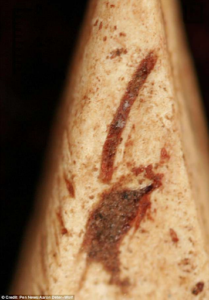By Courtney Akbar (Hassanamisco Nipmuc)
Pegg, last name once known, was a young Indigenous woman around twenty years of age in the year 1708. She served in some undefined unfree capacity (although likely enslaved) in the household of James Berry, a Boston mariner who lived on Black Horse Lane in Boston’s North End. On one Sunday evening in the month of May, she bravely left the home of Berry, with nothing but the clothes on her back. As was common, a week later Berry paid for an advertisement in the Boston News Letter, attempting to describe Pegg to the wider public and offering a reward for her return.
Not much is known about Pegg other than what can be learned about her in the newspaper advertisement. She is described as being tall, having a “mark or branch made in the flesh on her right arm, with powder or something else black,” and she also spoke broken English. No tribal or regional origins are provided. From this short description we can learn a few important details about Pegg.

The “mark or branch” on her right arm was most likely a tattoo. That she had a tattoo implies that she had spent her childhood to teen years among her family and tribe, since this likely could have marked her entrance into adulthood. In many Indigenous communities spanning North and South America, tattoos served, and continue to serve, as signs of kinship and community. They also hold important spiritual meaning, ranging from rites of passage into adulthood to symbolizing guardian spirits and personal responses to dreams. Traditional Indigenous tattooing methods use charcoal as well as red and yellow ochres—or oxides of iron; it is imperative to use charcoal to avoid infection. Three commonly used methods in Indigenous tattooing are “stick and poke” or “hand-poking,” which requires charcoal and needles made from bird or other animal bone; “cutting,” where tools such as obsidian and quartz flakes are used to cut lines into the skin, then charcoal along with an oil is rubbed into the skin; and “threading,” which uses a needle to pull thread through the skin where the pigment is intended to stay.
This tattoo coupled with Pegg having broken English makes it seem likely that she had been captured, slave traded, and sold to Berry not too long before her escape. Given Berry’s vocation as a mariner, Pegg was potentially captured in another region and taken to Boston, where she was sold into slavery. While her exact origins are unknown, the active English Indian slave trade in the Carolinas and on the Mosquito Shore (Central America) at the time suggests that she might have been forcibly taken from any number of places in the southeastern portion of North America or the Caribbean.
Like most self-emancipated people, Pegg is not described as having any belongings with her, bringing into question if she had any personal possessions at all. The advertisement did describe what she was wearing, in hopes that this would help people identify her. Berry noted that she had on “two Jackets, one Greenish, and two Petticoats, one Red, yellow Stockings, with Shoes.”
As with many such advertisements, this is the only document we have regarding Pegg. We don’t know whether she was found and returned to Berry, or if she had escaped back to her tribe or to a nearby one.
For further reading
DasSarma, Anjali, and Linford D. Fisher. “The Persistence of Indigenous Unfreedom in Early American Newspaper Advertisements, 1704–1804.” Slavery & Abolition, March 30, 2023, 1–25. https://doi.org/10.1080/0144039X.2023.2189517.
Gallay, Alan. The Indian Slave Trade: The Rise of the English Empire in the American South, 1670-1717. New Haven, CT: Yale University Press, 2002.